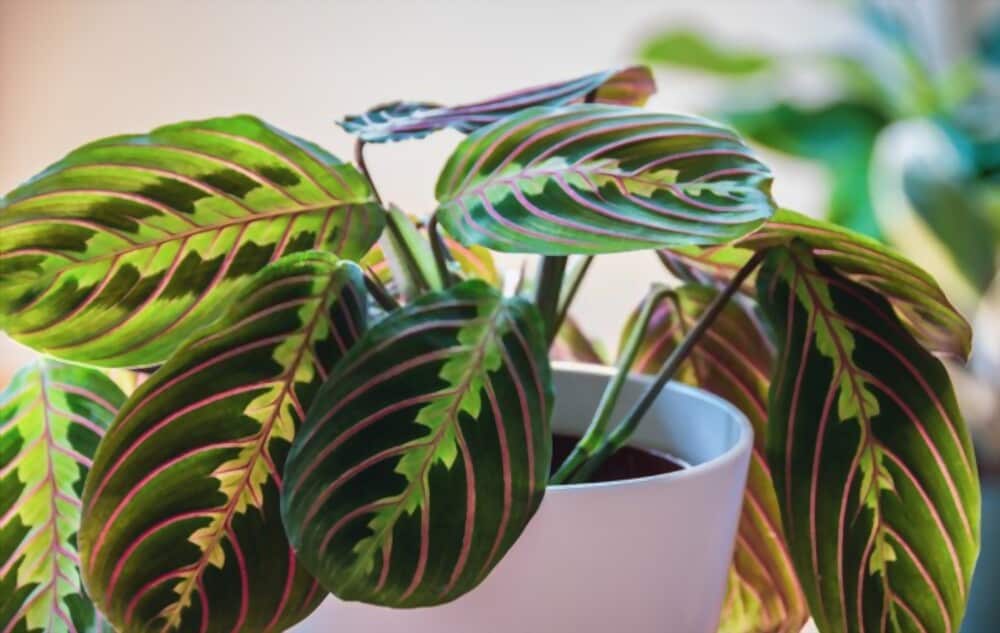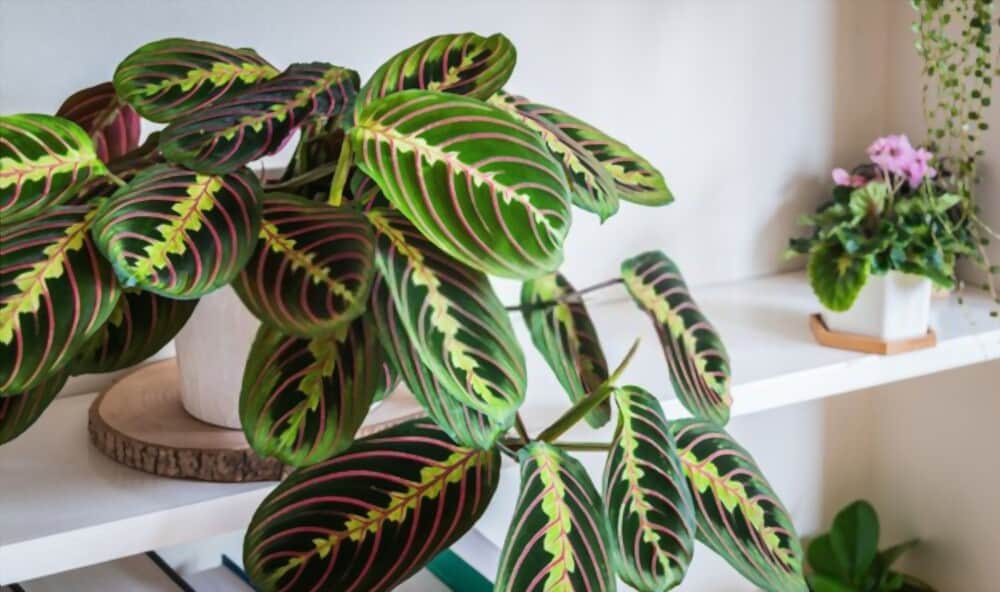Understanding how these plants grow in their natural environment is essential to comprehending why their leaves curl.
A biological reaction to a shortage of water is the curling of prayer plant leaves. Tropical plants known as “prayer plants” do well in high moisture and humidity situations. Regular watering, spraying the plant to maintain the surrounding humidity, and placing the plant in a cool location can all help reduce leaf curl.
The manner that plants respond to even slight changes in their environment can determine whether or not they survive the shift.
These alterations and ways to restore the plant to health are described in this article.

Table of Contents
Why do prayer plant leaves curl?
Maranta Leuconeura’s popular name refers to its leaf motion, which mimics praying hands.
The name “prayer plant” refers to this well-known characteristic of the plant. The edge of the leaf, which bends in the direction of the inner main ridge supporting the leaf, is where it curls.
The interesting thing about this is that these plants love to move and will do so to defend themselves, whether it’s to conserve moisture or ward off pests.
If you’re interested in raising the humidity, I’ve found a simple and affordable mister on Amazon that gives my indoor plants that extra humidity. Clicking here will take you there.
These are the different reasons that can trigger the curling effect:
1. Too Much Direct Light
In its natural environment, Maranta leuconeura grows low on the ground beneath a canopy of tropical plants.
Because of their native surroundings, these plants have many properties that help save light.
Typically, these plants are small and located beneath the shade of taller trees or woods, where they tend to absorb any available light and transform it into sugars for food.
Another purpose for their white or maroon bottoms is to completely trap and store the light, preventing it from passing through the leaves and being used later. It maximizes the light it actually receives in this way.
In order to defend themselves and preserve moisture that can be readily lost to the atmosphere, leaves that are exposed to excessive light sometimes curl or bend inward.
2. Not Enough Humidity
The amount of water vapor in the air is known as humidity. The humidity will be high if there is a lot of water vapor in the atmosphere. It feels wetter outside as the humidity rises.
Because of their native habitat, which is more tropical in nature, these plants thrive in moist, humid environments.
They have many water-saving traits, and one of them is the frequent usage of leaf curling to conserve water that would otherwise be lost to the environment on a dry day.
3. Temperature Extremes
We all utilize heaters to control the temperature inside our homes in colder climes, which is what we are subjected to during seasons like winter.
When the humidity in our home isn’t always conducive to water-loving plants, these heaters significantly reduce it.
The plants lose a lot of water through their leaves as a result of the dryness of the air around them.
Curling the leaf reduces the surface area exposed to the environment, which reduces water loss, and is a natural approach to reduce moisture loss.
Also contributing to the increase in water loss from the plant that causes the leaf curl reaction is direct sunshine.
4. Dry Soil from Poor Watering Habits
One reason why prayer plants’ leaves are soft to the touch and have a glossy appearance is that they enjoy dampness and high humidity.
Poor watering practices may cause the potting soil to dry out, depriving the plant of water.
Depending on the humidity and warmth of the surroundings, these plants normally need water every three to four days.
When it comes to remembering to water your houseplants, a mild alarm reminder can be useful, especially if you have a hectic schedule.
Setting a recurring alert on your phone or with Alexa is a straightforward approach to ensure that your plant receives the water it requires.
See our post on the ideal time for soil to remain moist following irrigation.
I occasionally spray my plants with water using this sturdy and highly efficient mister. Clicking here will take you there.
5. Poor Water Quality
Minerals and ions from the water provided to the plant have the potential to accumulate over time in the soil.
It also adheres to the roots of the plant as salts, which are ions in the solid structure. The ability of the roots to absorb water from the soil is hampered by an accumulation of solid material surrounding them.
These ions can therefore burn, turn brown, and curl.
Tap water, which typically contains high levels of salts, minerals, and fluoride, is one source of water that is known to add these.
I have discovered that utilizing distilled water does the trick in bringing your plant’s leaves back to a healthy state if this is the reason they are curling.
6. Root Bound
When plants outgrow the container they are in, they become root-bound. The plant’s roots tangle and occasionally you can detect roots poking through the ground.
A prayer plant that is rootbound may frequently wilt, grow slowly, produce smaller new leaves, and have leaves that yellow and curl.
This is due to the fact that there would be insufficient moisture and nutrients to meet the needs of the plant when its roots grew deeper into the little pot.
7. Pest Problems
Plants might experience a lot of issues as a result of pests. Scale, mealy bugs, and root mealy bugs are the three most prevalent pests. Pests like spider mites and fungus gnats are less frequent.
Mealybugs and scale both harm plants by sucking plant juices from the leaves, causing weak, wrinkled, and occasionally curled and bent plants.

How to correct the problems of leaf curling
Proper Watering Habits
Since prayer plants enjoy humidity, watering them every two to three days would help much.
When the top inch of soil around your prayer plant is dry, you can also water it. Pour water into the pot until it begins to drain through the drainage hole at the bottom, then drain any excess water into the saucer.
The bottom watering method is another tried-and-true technique for watering that aids in giving the plant the proper amount of liquid without overdosing it.
An easy bottom watering technique:
- For bottom watering, place your plant on a flat, open container.
- For the soil to absorb and get moist, add 1 inch of water to the container.
- Remove the plant after 15 to 20 minutes.
- Make sure the dirt is moist by lightly ticking your fingers into it.
- Allow the excess water to drain from the plant by setting it on a sink or other dry surface.
- From the watering tray, drain any extra water.
To learn how to bottom water plants, read our in-depth article.
Placement in the correct amount of Light
Place these plants away from windows and doors in a location with indirect light.
When choosing a setting for these plants, it is important to keep in mind that medium to low light is best for prayer plants.
These plants may thrive in offices as well as dimly light environments.
Rotating the plant
You may have observed that the prayer plant’s leaves move with the light as the day goes on.
Sometimes there is just one consistent direction of light, which can force the plant to stay in one place.
By giving the plant the same amount of light coming from all directions, rotating the plant sometimes sheds light on this problem. You can refer to my in-depth article on rotating houseplants for more information.
Rootbound Plants
Repotting in a bigger container will encourage growth. Plants kept in small, confined spaces adjust by growing more slowly.
Your plant will have more area to grow if you repotted it into a big pot. You may encourage the plants to grow larger more quickly by giving them more place to expand.
We advise using this affordable miracle grow soil for repotting because it encourages plant health through proper soil water drainage and aeration. Clicking here will take you there.
Reducing Pest Attacks
Move the diseased plants away from other plants to place them in quarantine.
When mealybugs are biting your succulent, use a sticky fly trap to catch them. You can also gently spray your succulent with alcohol or soap water to get rid of mealybugs.
After a few treatments using foliar spraying, neem oil is also effective against all of these insects.
The Takeaway
The highly worrisome characteristic of prayer plant leaf curl is used to make sure the plant survives extreme environmental conditions and even pest attacks.
Lack of moisture is the main cause of prayer plant leaves curling, aside from pests and the plant becoming root-bound.
You can prevent leaf curling by making sure the plant receives enough water and humidity.
This can be achieved by planning routine watering and positioning the plant in a location with consistent humidity.

FAQ
Where should I place my prayer plant?
Your prayer plant should be hung or placed close to a window so it may get some filtered light. Never place your plant in direct sunlight as this may cause the leaves to burn, develop spots or blotches, or lose color intensity. In general, prayer plants can tolerate locations with less light.
Why do they call it the prayer plant?
The leaves of this tough indoor plant frequently fold together at night, resembling a pair of praying hands, giving rise to its common name. The foliage of most varieties of prayer plants is variegated, which heightens the plant’s visual appeal. Although prayer plant does produce blooms, they are not abundant or particularly attractive.
What is special about a prayer plant?
The plant’s capacity to “pray” is its best feature. The plant’s reaction to light is what is known as a nastic movement. The leaves are flat during the day, but at night, they rise upward as if in prayer. Additionally, it enables the plant to store moisture at night.
Is a prayer plant good for indoors?
A Prayer plant is a good houseplant is because it’s simple to cultivate, has interesting foliage, and can withstand indoor conditions. A low, spreading plant known as a “prayer plant” that may grow horizontally down a tabletop or other surface and is frequently planted in hanging baskets.
